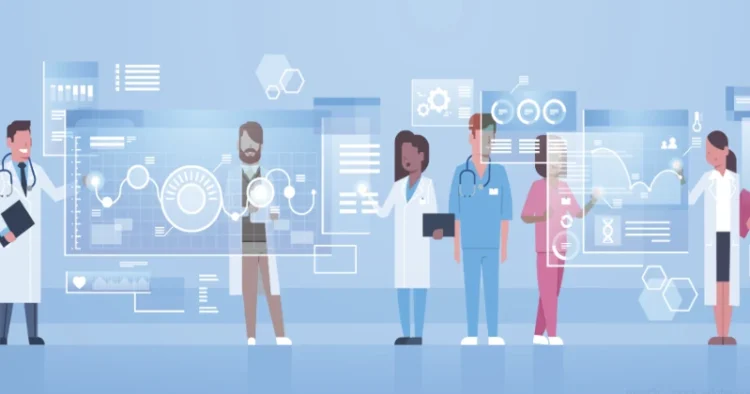Industry 4.0 is the fourth industrial revolution that focuses on the integration of advanced technologies such as the Internet of Things (IoT), Artificial Intelligence (AI), and Big Data Analytics to improve manufacturing processes and supply chain management. The healthcare industry is also adopting Industry 4.0 technologies to improve patient care and hospital operations.
The integration of Industry 4.0 technologies in hospitals can lead to several benefits such as improved patient outcomes, reduced costs, and increased efficiency. For example, IoT devices can be used to monitor patients’ vital signs remotely and alert healthcare providers in case of any abnormalities. AI can be used to analyze large amounts of patient data to identify patterns and predict potential health issues. Big Data Analytics can be used to optimize hospital operations by analyzing data from various sources such as electronic health records (EHRs), medical devices, and supply chain management systems.
According to a research paper by the University of Twente, there are various applications of Industry 4.0 in the Healthcare domain such as:
- Augmented Reality and Simulation: AR and simulation can be used to train healthcare professionals and simulate medical procedures.
- Autonomous Robotics: Autonomous robots can be used to perform repetitive tasks such as cleaning and disinfecting hospital rooms.
- Cybersecurity: Cybersecurity measures can be implemented to protect patient data and hospital systems from cyber attacks.
- Big Data Analytics: Big Data Analytics can be used to analyze large amounts of patient data to identify patterns and predict potential health issues.
- Internet of Things (IoT): IoT devices can be used to monitor patients’ vital signs remotely and alert healthcare providers in case of any abnormalities.
- Cloud Computing: Cloud computing can be used to store and access patient data from anywhere at any time.
Additive Manufacturing: Additive manufacturing can be used to create custom medical devices and implants. - Systems Integration: Systems integration can be used to integrate various hospital systems such as EHRs, medical devices, and supply chain management systems.
How Industry 5.0 can transform hospitals
Industry 5.0 is a new concept that aims to combine the benefits of Industry 4.0 with human-centricity. It is a new way of thinking about the future of manufacturing that focuses on the human element and how it can be integrated into the production process.
Especially, considering the post COVID era, “The New Normal”, we need to consider a human-centric solution that induces IoT and AI in healthcare. Previously, Industry 4.0 enabled mass customisation, which was not enough. Currently, the health industry is looking for mass personalisation having the human touch, so Industry 5.0 make them move from mass customisation to mass personalisation. It provides a product to the patients and healthcare professionals as per their specific requirements. This industrial revolution refers to the interaction between people and machines to make work better and faster.
Industry 5.0 is expected to benefit the healthcare industry (hospitals) in many ways. For example, it can help enhance human accuracy and deliver personalised treatment therapy that is highly effective for patients:
- Industry 5.0 can help improve patient care by using technology to create a more personalised experience for patients. For example, wearable devices can be used to monitor patients’ vital signs and alert doctors if there are any changes. Wearable devices are becoming a popular form of health monitoring and can help enhance human accuracy and deliver personalized treatment therapy that is highly effective for patients.
- Another way Industry 5.0 can transform healthcare is by using artificial intelligence (AI) to help doctors make better decisions. AI can analyze large amounts of data and provide insights that doctors might not have been able to see otherwise.
Overall, Industry 5.0 is still in its early stages, but it has the potential to revolutionize the healthcare industry by making it more efficient and effective. In this new normal life, a sensor with artificial intelligence will analyse the data quickly. Machines will be flexible to make high-level decisions according to patients’ needs. In the medical field, these technologies can measure and monitor the human body variable precisely as per the requirement of the patient. This helps track the body’s response with improved performance. It makes healthcare connected and accurately shares information digitally.
Digital Transformation in Hospitals
Digital transformation in healthcare is a shift from traditional models of care delivery to a new model of patient-centered, value-based care with the help of various technologies. It aims to improve quality, reduce costs, empower providers, and enhance the security of medical records. It affects every element of the healthcare practice, from clinical to logistical to institutional to public health. It also enables healthcare professionals to integrate a patient-focused approach, understand patient needs, establish loyalty and trust, and offer a better patient experience.
The four key areas where hospitals can leverage digital transformation to improve operational decision-making:
- Patient flow: Digital transformation can help hospitals improve patient flow by providing real-time data on patient status and location. This can help hospitals optimize patient flow and reduce wait times.
- Staffing: Digital transformation can help hospitals optimize staffing levels by providing real-time data on patient volume and acuity. This can help hospitals ensure that they have the right number of staff with the right skills at the right time.
- Scheduling: Digital transformation can help hospitals optimize scheduling by providing real-time data on patient volume and acuity. This can help hospitals ensure that they have the right number of staff with the right skills at the right time.
- Supply chain management: Digital transformation can help hospitals optimize supply chain management by providing real-time data on inventory levels and usage patterns. This can help hospitals ensure that they have the right supplies on hand when they are needed.




















Comments